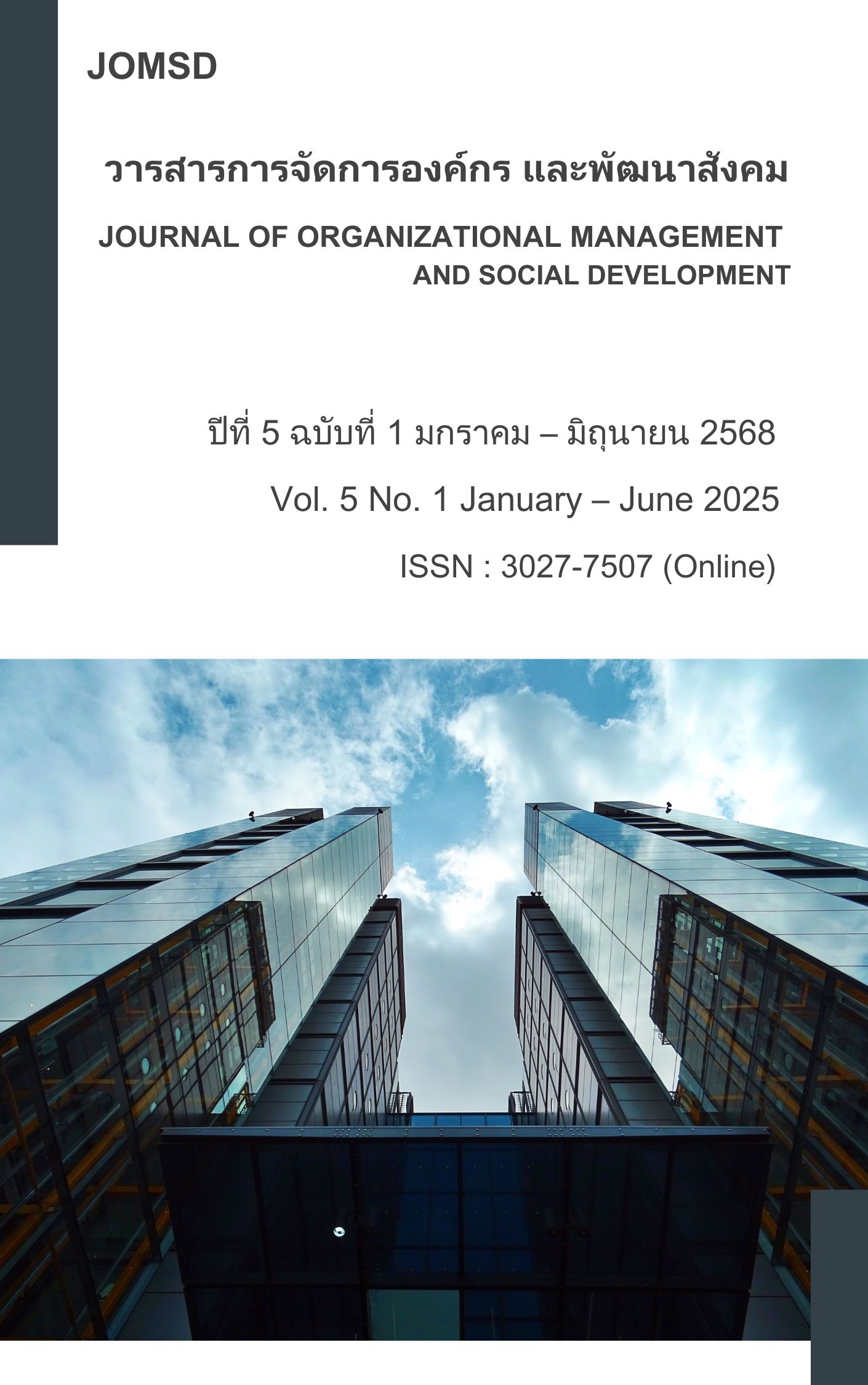การพัฒนาทุนมนุษย์ในยุคดิจิทัลของหัวหน้างานในโรงงานอุตสาหกรรมการเคลือบ
Main Article Content
บทคัดย่อ
บทความนี้มีวัตถุประสงค์เพื่อศึกษาการพัฒนาทุนมนุษย์ในยุคดิจิทัลของหัวหน้างานในโรงงานอุตสาหกรรมการเคลือบ ซึ่งเป็นส่วนที่มีความสำคัญต่อการผลิตในอุตสาหกรรมต่าง ๆ เช่น ยานยนต์ อิเล็กทรอนิกส์ และวัสดุก่อสร้าง การเปลี่ยนผ่านสู่ยุคดิจิทัลได้ส่งผลต่อรูปแบบการทำงานและความสามารถที่จำเป็นของหัวหน้างาน ดังนั้นการพัฒนาทุนมนุษย์จึงต้องเน้นทั้งทักษะด้านเทคโนโลยี การบริหารจัดการความเปลี่ยนแปลง และภาวะผู้นำในบริบทดิจิทัล บทความนี้นำเสนอหัวข้อนวัตกรรม การพัฒนาทุนมนุษย์ การพัฒนาทุนมนุษย์ในยุคดิจิทัลของหัวหน้างาน และการพัฒนาทุนมนุษย์ในยุคดิจิทัลของหัวหน้างานในโรงงานอุตสาหกรรมการเคลือบ ผลการศึกษาแสดงให้เห็นว่าการพัฒนาทุนมนุษย์ในมิติที่หลากหลายสามารถเสริมสร้างขีดความสามารถในการแข่งขันขององค์กร และเพิ่มประสิทธิภาพการดำเนินงานในภาคอุตสาหกรรมการเคลือบได้
Article Details
เอกสารอ้างอิง
กนกกาญจน์ พวงเพ็ชร, สุนิตดา เทศนิยม, ธีรพล กาญจนากาศ และสมคิด ดวงจักร. (2568). การบริหารทรัพยากรมนุษย์ที่มีผลต่อประสิทธิภาพการบริหารงานของสำนักงานเทศบาลตำบลบางใหญ่ จังหวัดนนทบุรี, Journal of Spatial Development and Policy, 3(2), 57-68.
กรมพัฒนาฝีมือแรงงาน. (2564). แนวทางการพัฒนาทักษะแรงงานในยุคดิจิทัล. กรุงเทพฯ: กระทรวงแรงงาน.
กรมอนามัย. (2565). การพัฒนาทรัพยากรมนุษย์ในยุคดิจิทัล. สืบค้นจาก https://person.anamai.moph.go.th.
กองยุทธศาสตร์และแผนงาน สศอ. (2565). กลยุทธ์การส่งเสริมอุตสาหกรรมแห่งอนาคต. กรุงเทพฯ: สำนักงานเศรษฐกิจอุตสาหกรรม.
ณ.ชนม์ ประยูรวงศ์. (2566). ความเสี่ยงของการบริหารทุนมนุษย์ในยุคดิจิทัล. วารสารวิชาการสถาบันเทคโนโลยีแห่งสุวรรณภูมิ, 9(1), 316-327.
ผู้จัดการออนไลน์. (2567). งานสัมมนาสุดยอดเทคโนโลยีอุตสาหกรรมการเคลือบและการชุบพื้นผิวจีน-ไทย (กรุงเทพฯ) จัดขึ้นอย่างประสบความสำเร็จ. สืบค้นจาก https://mgronline.com/onlinesection/ detail/9670000062773.
พระมหาธีรวีร์ ธีรวฑฺฒนเมธี (พันธ์ศรี). (2566). แนวคิดเรื่องทุนมนุษย์: ทรรศนะจากทฤษฎีเศรษฐศาสตร์ร่วมสมัย และพุทธปรัชญา. (พุทธศาสตรดุษฎีบัณฑิต, มหาวิทยาลัยมหาจุฬาลงกรณราชวิทยาลัย).
พระมหาสุเทพ สุเทวเมธี. (2556). การบริหารงานบุคคลขององค์กรบริหารส่วนตำบลในเมือง จังหวัดพิษณุโลก. (พุทธศาสตรหาบัณฑิต, มหาลัยมหาจุฬาลงกรณราชวิทยาลัย).
พัชรินทร์ ดีอินทร์. (2566). HR ยุคดิจิทัล กับ 5 ทักษะที่ควรมี. สืบค้นจาก http://www.pmat.or.th/ความรู้ทรัพยากรบุคคล/1712/สะดุดคิด สะกิดใจ/20701/gallery1/?contentid=37885.
วรัชยา ศิริวัฒน์. (2566). การพัฒนาศักยภาพทุนมนุษย์ในยุคดิจิทัล : กรณีศึกษามหาวิทยาลัยรามคำแหง. วารสารสังคมศาสตร์และวัฒนธรรม. 7(4). 269-280.
สภาพัฒนาการเศรษฐกิจและสังคมแห่งชาติ. (2561). ยุทธศาสตร์ชาติ พ.ศ. 2561-2580 (ฉบับย่อ). https://www.nesdc.go.th/download/document/SAC/NS_SumPlanOct2018.pdf.
สมาคมการพิมพ์ไทย. (2561). การเคลือบ (Coating Method). วารสารการพิมพ์ไทย, 117, 40-45.
สมาคมอุตสาหกรรมสีและเคลือบผิวแห่งประเทศไทย. (2563). รายงานอุตสาหกรรมการเคลือบ. กรุงเทพฯ: สมาคมอุตสาหกรรมฯ.
สำนักงานคณะกรรมการส่งเสริมการลงทุน. (2564). รายงานแนวโน้มกลุ่มอุตสาหกรรมเป้าหมาย. กรุงเทพฯ: สำนักงานคณะกรรมการส่งเสริมการลงทุน.
สำนักงานเศรษฐกิจอุตสาหกรรม. (2563). รายงานอุตสาหกรรมเป้าหมายเพื่อการพัฒนาที่ยั่งยืน. กรุงเทพฯ: กระทรวงอุตสาหกรรม.
สำนักงานส่งเสริมเศรษฐกิจดิจิทัล. (2565). Digital Skills for the Future Workforce. กรุงเทพฯ: สำนักงานส่งเสริมเศรษฐกิจดิจิทัล.
สำนักงานสถิติแห่งชาติ. (2567). จังหวัดสมุทรสาคร. กรุงเทพฯ: สำนักงานสถิติแห่งชาติ กระทรวงดิจิทัลเพื่อเศรษฐกิจและสังคม.
สุวิทย์ เมษินทรีย์. (2556). ทุนมนุษย์และทุนทางสังคม: พลังขับเคลื่อนเศรษฐกิจและสังคม. กรุงเทพฯ: มหาวิทยาลัยธรรมศาสตร์.
อัจฉรา รักยุติธรรม. (2559). การพัฒนาทุนมนุษย์ในยุคเศรษฐกิจฐานความรู้. วารสารวิชาการมหาวิทยาลัยราชภัฏศรีสะเกษ, 10(1), 21-33.
Amabile, T. M. (1998). How to kill creativity (Vol. 87). Boston, MA: Harvard Business School Publishing.
Bai, Y. (2024). A Study of the Impact of Human Capital Investment on Organizational Performance. Highlights in business, economics and management, 32, 210-216.
Becker, G. S. (1993). Human Capital: A Theoretical and Empirical Analysis, with Special Reference to Education. (3rd ed.). Chicago: University of Chicago Press.
Davenport, T. H., & Ronanki, R. (2018). Artificial intelligence for the real world. Harvard business review, 96(1), 108-116.
Dubina, I. N., Carayannis, E.G., & Campbell, D.F.J. (2012). Creativity Economy and a Crisis of The Economy? Coevolution of Knowledge, Innovation, and Creativity, and of The Knowledge Economy and Knowledge Society. Journal of the Knowledge Economy, 3(1), 1-24.
Entraining, (2561). การพัฒนาทุนมนุษย์ขององค์กรเพื่อการเตรียมความพร้อม ตอนจบ. สืบค้นจาก https://www.tlaa.org.
Fang, L. Y. (2024). How New Human Capital Can Enhance the Competitiveness of Individuals and Organizations. Highlights in business, economics and management, 29, 164-168.
Gilley, J. W., & Eggland, S.A. (2019). Principles of Human Resource Development. Reading, MA: Addison-Wesley.
IdeaScale. (2023). นวัตกรรมคืออะไร? ความหมาย ประเภท ตัวอย่าง และกระบวนการ. สืบค้นจาก https://ideascale.com/th/%E0%B8%9A%E0%B8%A5%E0%B9%87%E0%B8%AD%E0%B8%81/aairkhuuenwatkrrm/.
Janssen, O. (2005). The joint impact of perceived influence and supervisor supportiveness on employee innovative behaviour. Journal of occupational and organizational psychology, 78(4), 573-579.
Jobsdb. (2024). มัดรวม! 15 นวัตกรรมสุดเจ๋งใหม่ๆ ที่จะมาปฏิวัติการทำงานในอนาคต. สืบค้นจาก https://th.jobsdb.com/th/career-advice/article/new-trend-innovation.
Mara, C. C. (2021). The Emergence of Risk and Return on Human Capital Development. Retrieved from https://www.intechopen.com/chapters/75366.
Melnichuk, M. V. (2023). Emotional Intelligence as a Factor in the Development of the Intellectual Capital of the Organization. Management Sciences, 13(2), 26-35.
Nadler. L. (1980). Corporate Human Pesources Development. New York: American For Training and Development.
OECD. (2021). Enhancing Industrial Policy in Thailand: Boosting Productivity and Competitiveness. Retrieved from https://www.oecd.org/en/publications/boosting-productivity-and-living-standards-in-thailand_e525c875-en.html.
OECD. (2021). The Digital Transformation of SMEs. Retrieved from https://www.oecd.org/en/publications/the-digital-transformation-of-smes_bdb9256a-en.html.
Pace, R. W., Smith, P.C & Mills, G.E. (1991). Human Resource Development. New York: Prentice-Hall.
Samoilovych, A., Popelo, O., Kychko, I., Samoilovych, O., & Olyfirenko, I. (2022). Management of human capital development in the era of the digital economy. Journal of Intelligent Management Decision, 1(1), 56-66.
Schultz, T. W. (2018). Capital Formation by Education. Journal of Political Economy, 68(6), 571-583.
Spaceship. (2566). 7 คุณสมบัติสำคัญ … เพื่อส่งเสริมให้คุณเป็นหัวหน้าที่ดียิ่งขึ้น. สืบค้นจาก https://www.spaceship.in.th/knowledge-base/46.
Spraggon, M., & Bodolica, V. (2008). Understanding Successful Innovation through Different Theoretical Lense/Net s: The Case of Institutional, Resource–Based and Social Capital work Perspectives. Sasin Journal of Management, 14(1), 117-133.
Toppro. (2566). 9 ทักษะสําหรับการก้าวสู่หัวหน้างานมืออาชีพ. สืบค้นจาก https://hr-odthai.com/blog/.
Toppro. (2567). การพัฒนาทักษะหัวหน้างาน (Supervisory Skill Development). สืบค้นจาก https://www.hr-odthai.com/blog/.
Wayne, F. (2003). Managing Human Resource: Productivity Quality of Work Life, Profits. New York: McGraw-Hill.
Weiner, B. J. (2020). A theory of organizational readiness for change. In Handbook on implementation science (pp. 215-232). Cheltenham: Edward Elgar Publishing.
World Bank. (2022). Thailand Economic Monitor Reports. Retrieved from https://www.worldbank.org/en/country/thailand/publication/thailand-economic-monitor-reports.
World Economic Forum. (2023). World Economic Forum Future of Jobs Report 2023. Switzerland: The Future of Jobs Report.

